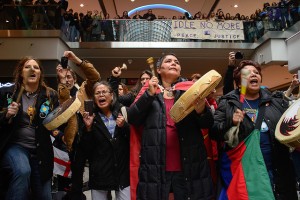
Idle No More (INM), started in late 2012 as an aboriginal movement to block regressive legislation threatening indigenous, territorial and treaty claims in Canada, has quickly become a worldwide vehicle for indigenous peoples’ rights and environmental complaints. By early 2013 It has attracted significant attention from Latin American quarters.
Participants have availed themselves of an array of social media to further their causes, deriving inspiration and impetus from Mexico’s Zapatistas’ Dec. 21 occupation of Chiapas state’s municipal plazas.
Canada’s Call
The INM mobilization began as a response to the efforts of Canadian Prime Minister Steven Harper and his Conservative Party to pass omnibus legislation – or a wide-reaching law — repealing protections afforded to First Nations and natural resources, among other things.
On Nov. 10, he movement launched with an event in Saskatchewan Province prepared by Indian rights advocates Jessica Gordon, Sheelah McLean, Sylvia McAdams and Nina Wilsonfeld. Today Idle No More has gone viral, largely due to publicity shared on the digital moccasin telegraph.
INM gained momentum with demonstrations breaking out across Canada and abroad after Chief Theresa Spence of the Attawapiskat First Nation community in Canada’s Ontario Province lent her support to the movement by going on a hunger strike Dec. 10, during the National Day of Action called to celebrate the end of the first month of protest.
Bill C-45, the omnibus legislation, contained amendments to the Indian Act facilitating the surrender of indigenous reserves. The amendments called for removing a requirement that all members of First Nations be involved in referendums about land proposals.
A provision funding changes of the Navigable Waters Protection Act entailed giving 99 percent of lake and river water to industry. Changes to the Fisheries Act were destined to eliminate critical environmental safeguards and review processes for natural resource exploitation.
The entire set of proposals stemmed from a political climate of increasing government restrictions on access to environmental information and public participation in Canada’s decision-making processes.
Demonstrators in North America utilized the recently popularized flash-mob format of protest, consisting of nearly spontaneous gatherings at shopping malls, where hand drums, singers and circle dancing frequently helped to express resistance.
Celebrity protesters, including actress Tantoo Cardinal and singer-songwriter Buffy Ste. Marie, a Cree First Nations member and Hawaii resident, went on record in support of Idle No More, calling on Harper to accede to hunger strikers’ demands.
“Prime Minister Harper, please see this opportunity to represent, on behalf of all Canadians, the fact that we can make things better now,” Buffy pleaded in a video spot.
INM organizers called on “all nations to drum and sing across Turtle Island on the solstice Dec. 21, 2012 for a global synchronized spiritual awakening.”
Despite the hullabaloo, Bill C-45 passed into law as part of the 2012 Jobs and Growth Act in late December. It was a budget implementation measure. Like the June 2012 Jobs Act, it enlarged on an amalgam of legal instruments to destroy the environment. Each bill contained some 450 pages, prompting critics’ assertions that lawmakers neither read nor understood the wording.
Although Harper agreed to end the hunger strike by meeting with Spence and the officially recognized Assembly of First Nations on Jan. 11, all INM’s activity failed to achieve a simultaneous audience with the Crown’s representative, Gov. Gen. David Johnston, who holds sway over land rights decisions.
So Spence and fellow fasters continued their vigil for a total of six weeks until Jan. 24, when the Assembly of First Nations, together with the Liberal and New Democrat Party caucuses, committed to actively support the demands of the action.
But by then, the demands had broadened in scope beyond even omnibus status to take into account international concerns being addressed globally and at the United Nations:
- An immediate meeting between the Crown, the federal and provincial governments, and all First Nations to discuss treaty and non-treaty-related relationships.
- Clear work plans and timelines, and a demand that the housing crisis within First Nations communities be considered as a short-term immediate action.
- Frameworks and mandates for implementation and enforcement of treaties on a nation-to-nation basis.
- Reforming and modifying a land-claims policy.
- A commitment towards resource revenue sharing, requiring the participation of provinces and territories.
- A commitment towards sustained environmental oversight over First Nations lands.
- A review of Bill C-38 and C-45 to ensure consistency with constitutional requirements about consultation with aboriginal peoples.
- Ensure that all federal legislation has the consent of First Nations where inherent and Treaty rights are affected.
- The removal of funding caps and the indexing of payments made to First Nations.
- An inquiry into violence against indigenous women.
- Equity in capital construction of First Nation schools and additional funding support for First Nation languages.
- A dedicated cabinet committee and secretariat within the Privy Council Office responsible for the First Nation-Crown relationship.
- Full implementation of the United Nations declaration of the rights of indigenous peoples.
The demands were backed by a “Manifesto”, also dated Jan. 24, which stated the principles behind them:
• We contend that: The treaties are nation to nation agreements between The Crown and First Nations who are sovereign nations. The treaties are agreements that cannot be altered or broken by one side of the two nations. The spirit and intent of the treaty agreements meant that First Nations peoples would share the land, but retain their inherent rights to lands and resources. Instead, First Nations have experienced a history of colonization which has resulted in outstanding land claims, lack of resources and unequal funding for services such as education and housing.
• We contend that: The state of Canada has become one of the wealthiest countries in the world by using the land and resources. Canadian mining, logging, oil and fishing companies are the most powerful in the world due to land and resources. Some of the poorest First Nations communities have mines or other developments on their land but do not get a share of the profit. The taking of resources has left many lands and waters poisoned – the animals and plants are dying in many areas in Canada. We cannot live without the land and water. We have laws older than this colonial government about how to live with the land.
• We contend that: Currently, this government is trying to pass many laws so that reserve lands can also be bought and sold by big companies to get profit from resources. They are promising to share this time…Why would these promises be different from past promises? We will be left with nothing but poisoned water, land and air. This is an attempt to take away sovereignty and the inherent right to land and resources from First Nations peoples.
• We contend that: There are many examples of other countries moving towards sustainability, and we must demand sustainable development as well. We believe in healthy, just, equitable and sustainable communities and have a vision and plan of how to build them. Please join us in creating this vision.
Dissidents went on to gather more than 1,030 signatures on an Internet petition for delivery Feb. 28 to Harper and the Conservative Party, stating:
“We, the Canadian people, want the government to revisit Omnibus Bill C-45, take out the re-designation of aboriginal land rights, and re-protect our navigable waterways, lakes and rivers.”
In the meantime, over the weekend of Jan. 5-6, protestors took to the international boundary crossings between Canada and the United States, slowing down traffic to raise their points. They scheduled a Jan. 28 Idle No More World Day of Action.
Canadian INM events took place not only in First Nations from Aamjiwnaang to the Yukon, but also in the urban centers of Calgary, Halifax, Hamilton, Kelowna, Kingston, Manitoba, Montreal, Nelson, Ottawa, Edmonton, Regina, Saskatoon, Toronto, Victoria, Windsor, Winnipeg, Yorkton and others.
Latinos Join Idle No More
Before long, demonstrators organized solidarity actions in the U.S. states of Alaska, Arizona, California, Colorado, Hawaii, Iowa, Maine, Michigan, Minnesota, Nevada, New Mexico, New York, North Carolina, Oregon, Oklahoma, South Dakota, Texas, and Wisconsin, among others.
Activists in European, African, and Asian nations also took part. While Idle No More rallies were scarce in the Americas south of the U.S. border, the many Latin Americans of indigenous descent who find themselves in the United States and Canada jumped on board.

They are flying the banner of decolonization from the streets of East Los Angeles to the snow banks of Edmonton. Latin American Researchers of Ontario has organized Latino/as in Solidarity with Idle No More, attracting the support of the Canadian Hispanic Congress, Toronto’s Casa Maíz, Edmonton’s Latin American Community Engagement Network, Memoria Viva and The Community Networks Group; the Canadian Revista Latinoamericana Refundación; Arizona’s One Voice Radio, and Massachusetts’ Latino Rebels.
The extended reach of the INM movement has forged alliances across racial lines and widened the focus of activities to include related struggles. Original demands for indigenous autonomy, tribal sovereignty and self-determination have broadened; opposition to fracking and horizontal drilling for oil and tar-sands oil pipeline proposals are among the top U.S. Native American environmental concerns incorporated in the movement platform. Human rights issues addressed include migrants’ and Australian aboriginals’ concerns.
Still gaining momentum five months after inception, Idle No More participants are set to celebrate the “native spring” with a Global Day of Ceremony and Resurgence on March 20, Vancouver’s Annual Community March Against Racism March 23, and Buffy Sainte Marie’s Indigenous “No Tar-Sands” Concert in Oklahoma March 24, as well as teach-ins in various cities throughout the month.
The scene is set for the great potential of much further participation from Latin American activists.
Talli Nauman is an environmental journalist and organizer and columnist for the CIP Americas Program www.americas.org



